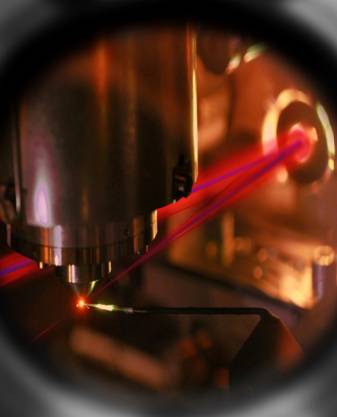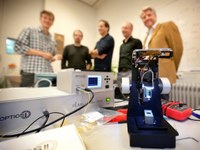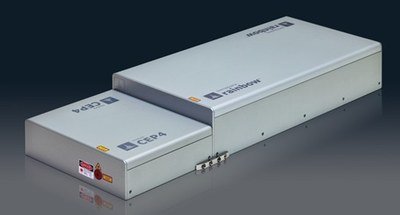Science and industry: a two-way street
Ultrafast Innovations – MPQ

 |
|---|
|
View inside a vacuum chamber at UFI |
Ultrafast Innovations GmbH (UFI) was founded in 2009 as a spin-off from the Ludwig- Maximilians-Universität München (LMU) and the Max Planck Gesellschaft (MPG), Germany, which are also the stockholders of the company. The objective of UFI is to provide commercialized solutions developed at LMU and the Max Planck Institute for Quantum Optics (MPQ), especially by the groups of Ferenc Krausz and Ulf Kleineberg, to the growing ultra-short-pulse laser community. UFI does this with success, as is shown by recent projects such as the installation of a beamline for attosecond streaking experiments for the King Saud University in Saudi Arabia, and the design and development of a new enhancement cavity for the Friedrich Schiller University in Jena, Germany. In general, UFI provides optical elements suited for ultra-short laser pulses, ranging from the infrared to extreme ultraviolet and x-rays. “The idea is to use the technological and research expertise for industrial projects in a straight-forward way”, says Hans Koop, UFI’s current CEO. According to him, much of the success of the company should be credited to the vision and engagement of Ferenc Krausz who initiated the founding of UFI. UFI, which has 10 employees, takes care of engineering, product development, and customer relations, whereas science remains the main task of the research groups of Ferenc Krausz and Ulf Kleineberg. Koop: “That means that UFI is basically working at the fount of new products and that UFI has access to passionate coworkers who made their profession their hobby. We really hope that UFI is beneficial for the people and all research institutions of the Garching research campus.
http://www.ultrafast-innovations.com/
Light4Tech – LENS

Light4Tech was founded as a joint venture between a group of academic researchers from the European Laboratory for Non-linear Spectroscopy (LENS) in Florence and several industrial partners in 2005. The company itself stands halfway between the worlds of research and industry, and it offers prototyping and technology transfer services mainly in the fields of photonics and (bio)physics. As such, it intends to fill the gap between basic research and industrial research. The company’s know-how includes microscopy, biological imaging, machine vision, and image and data analysis. It employs five people. Light4Tech is a versatile company: it not only works for high-tech companies that would like to develop a new product, but it is also hired to create products based on ideas from academic groups. It owns state-of-the-art labs, says Domenico Alfieri: “Our laboratories consist of two experimental rooms with a very accurate air control system. That’s a prerequisite for advanced optical research. The labs are equipped with optical tables and related optical and electrical tools and chemicals.” These labs are not only used by Light4Tech: the company also offers private and public researchers access to their labs. “A typical approach with L4T starts with a joint technical discussion about the idea or product to be developed”, says Alfieri. “This is then followed by a technical and economic feasibility study, which is performed by L4T.” Which ideas from the labs of LENS, the University of Florence, and other academic partners are eligible for the ‘L4T treatment’ is decided by a Scientific Committee together with an Industry Panel. Alfieri: “They evaluate the most promising research in terms of results and devices, looking at the potential market, to see which ideas can be patented or industrialised by L4T. Our motto is: we give legs to ideas.”
http://www.l4t.it/
Optics11 – LaserLaB Amsterdam

 |
|---|
| The ‘fibre-top’ atomic force microscope by Optics11. © Yvonne Compier |
In 2011, Davide Iannuzzi, University Research Chair Professor at LaserLaB Amsterdam, teamed up with serial entrepreneur Hans Brouwer to found Optics11. The company markets the ‘fibre-top’ technology Iannuzzi invented. This technology allows producing an atomic force microscope probe at the end of an optical fibre, which can be used at a distance in harsh and wet environments. The method uses a tiny cantilever at the tip of the probe, which reflects light back into the fibre. The idea dates back to 2005. At the time, Iannuzzi tried to solve a technical problem related to one of his nanoscale experiments when he sketched the design of a new device based on an optical fibre. The Italian realized that using this design he could not only overcome the particular problem he was trying to solve, but that it had the potential to become a new platform for all kinds of miniaturised optomechanical sensors. After building a prototype for his laboratory, Ianuzzi decided he wanted to transform his idea into a mature technology. Since then, among other grants, Iannuzzi collected a Starting Grant, a Proof-of-Concept and a Consolidator Grant from the ERC to develop his fibre-top technology, which is now being used in ten different countries. ”Academic entrepreneurship is a healthy exercise: it has been teaching me the difference between doing and delivering, while still widening my scientific horizon”, Iannuzzi said about his commercial adventure on the recent occasion of his inaugural lecture as University Research Chair Professor. “Going outside the comfortable rooms of my own laboratory required a change of mindset. The focus had to shift from what we were doing for us to what we wanted to deliver to others. But the effort had its payback. Thanks to the spread of my technology, I am meeting scientists from the widest range of disciplines, which leads to many enlightening discussions.”
Femtolasers – MBI

 |
|---|
|
Femtolasers’ rainbow oscillator with CEP4 module. |
The group of Günter Steinmeyer from the Max Born Institute for Nonlinear Optics and Short-Pulse Spectroscopy (MBI, Berlin) developed a method to stabilise the Carrier-Envelope Phase (CEP) of laser pulses. MBI had a patent filed, which was later transferred to Femtolasers Produktions GmbH in Vienna. Femtolasers now sells the CEP4™ method as an add-on to their FEMTOSOURCE™ rainbow™ series of ultrafast oscillators. Since MBI’s research is mostly directed at fundamental science, patents are more an exception than a rule. Nevertheless Nevertheless, the institute strongly supports patenting of relevant ideas and some of them are sold or licensed. According to Steinmeyer, MBI was already an important customer of Femtolasers. “MBI has one of the biggest installations of Femtolasers’ products in Europe. When we contacted them about the CEP stabilisation method, they immediately showed great interest. We then demonstrated the idea in the presence of several people from Femtolasers. The result was published in Nature Photonics in 2010, with an equal number of co-authors from MBI and Femtolasers.” Next, Femtolasers took over and developed the lab demonstration into a product, while MBI agreed to support this process in any way possible. “There were a lot of technical questions and solutions, which we mostly discussed on the phone or via email; the payback has been a few more shared publications”, says Steinmeyer. MBI wants to show that their ideas are not only of theoretical nature, but that they really enable superior stabilisation, he says. “We had to make it very clear that the feed-forward scheme is not just a cheap and inferior work-around for the proven feedback technology. And this can only be done by peerreviewed publication in some of the top journals. In turn, this is the best advertisement that Femtolasers can get.”
SourceLAB – LOA

SourceLAB is a spin-off from the Laboratoire d’Optique Appliquée (LOA) in Palaiseau near Paris. It was founded in February 2011 by Antonin Borot and François Sylla based on their thesis works at LOA during the previous years. The company provides innovative targets and complete systems (laser, target, and detector) to generate and manipulate beams of particles and high-energy radiation. CEO François Sylla recounts about the earliest stages of the conception of the company: “One year before the defense of my PhD thesis, I decided to start an entrepreneurial adventure in parallel to the scientific work I was carrying out. The company I intended to create, SourceLAB, should bring the technological fruits of four years of developments in the lab to the market, with the help of the technical expertise I acquired at LOA.” Sylla therefore decided to spend the last year of his thesis work not only on the scientific side of the field of laser-plasma interaction, but to explore also the economic and societal side. “Laser-plasma interaction in the so-called ‘underdense regime’, implemented by focusing an intense laser onto a gas jet, can be used to create relatively cheap and very compact accelerators delivering beams of very energetic electrons and ions”, explains Sylla. “These beams have very interesting properties for scientific, industrial and medical applications.” They could be used for such different applications as cancer radiotherapy, electron beam etching of integrated circuits, irradiation sterilisation of food, non-destructive testing of dense materials, and dating works of art. Sylla’s thesis work paved the way towards compact and energy-efficient laser-plasma accelerators, he says, allowing investigation within a wide range of plasma and laser parameters. In its first year, 2011, SourceLAB had two patents filed, and it was awarded an ERC Proof of Concept grant in the same year.
http://www.sourcelab-plasma.com/
Menlo Systems – MPQ

Menlo Systems is a spin-off from the Max Planck Institute of Quantum Optics (MPQ) in Garching, Germany. It was founded by MPQ Director Theodor Hänsch and his coworkers Ronald Holzwarth and Michael Mei in 2001. Menlo’s products are based on the frequency comb technology that brought Hänsch the 2005 Nobel Prize in Physics. The company currently employs more than seventy people. A Nobel Prize being awarded for the technology you are trying to sell, does not hurt the business, says CEO Michael Mei. “But, actually, we managed to be profitable since early on, after collecting a small amount of private money and a grant from the German government for spin-offs. Also, some of our earliest customers pre-paid for the first units. But I am happy that we already started the business before the Nobel Committee decided to give the prize to Hänsch; the day the prize was announced our web statistics went out of the roof. And, more important, Ted Hänsch has been the best advisor you can think of from the very first day and he is exposed to many potential customers.” Another reason for Menlo’s success lies, according to Mei, in the company’s attitude. “We always try to make life as easy as possible for our customers. With every frequency comb and other products we also share some of our knowledge with the customers. Indeed, most of the time this is a two-way interchange; we get many things back from them as well.” It helps that he and Menlo’s CTO Ronald Holzwarth are both scientists, Mei thinks. “In most places I have been you encounter incredibly smart people, and often it is such a pleasure to work with them that you forget how hard you actually work. If our employees feel the same, I think we do things right.”

